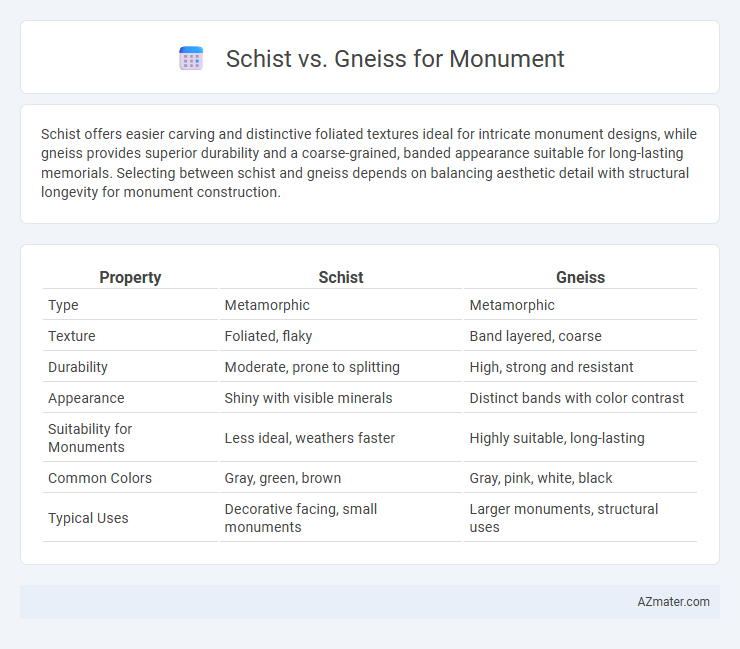Schist offers easier carving and distinctive foliated textures ideal for intricate monument designs, while gneiss provides superior durability and a coarse-grained, banded appearance suitable for long-lasting memorials. Selecting between schist and gneiss depends on balancing aesthetic detail with structural longevity for monument construction.
Table of Comparison
| Property | Schist | Gneiss |
|---|---|---|
| Type | Metamorphic | Metamorphic |
| Texture | Foliated, flaky | Band layered, coarse |
| Durability | Moderate, prone to splitting | High, strong and resistant |
| Appearance | Shiny with visible minerals | Distinct bands with color contrast |
| Suitability for Monuments | Less ideal, weathers faster | Highly suitable, long-lasting |
| Common Colors | Gray, green, brown | Gray, pink, white, black |
| Typical Uses | Decorative facing, small monuments | Larger monuments, structural uses |
Introduction to Schist and Gneiss Stones
Schist and gneiss are metamorphic rocks commonly used in monuments due to their durability and unique textures. Schist features a foliated structure with visible mineral grains like mica that create a shimmering appearance, while gneiss exhibits banded layers with alternating lighter and darker minerals such as quartz and feldspar. Both stones offer distinct aesthetic qualities and strong resistance to weathering, making them ideal choices for long-lasting, visually striking monuments.
Geological Formation of Schist vs Gneiss
Schist forms through medium-grade regional metamorphism, characterized by the alignment of platy minerals like mica, resulting in a foliated texture with pronounced schistosity. Gneiss develops under higher-grade metamorphic conditions, exhibiting compositional banding due to the segregation of light and dark mineral layers, often quartz, feldspar, and biotite. The difference in metamorphic intensity and mineral alignment between schist and gneiss significantly influences their durability and suitability for use in monuments.
Key Physical Properties of Schist and Gneiss
Schist features a foliated texture with visible mica flakes, offering a shiny and flexible surface ideal for decorative monuments, while gneiss displays a banded structure with alternating light and dark mineral layers, providing greater durability and resistance to weathering. The key physical properties of schist include moderate hardness and ease of carving, contrasted by gneiss's higher hardness and structural strength, which contribute to its suitability for large, enduring structures. These differences in mineral composition and texture influence the choice between schist and gneiss, balancing aesthetics with long-term stability in monumental applications.
Appearance and Aesthetic Differences
Schist exhibits a foliated texture with visible mineral grains and a shiny, glittery surface due to mica content, offering a rough, natural look ideal for rustic monuments. Gneiss features distinct banding with alternating light and dark mineral layers, providing a striking, striped appearance that lends an elegant and formal aesthetic to memorial structures. The coarse, granular pattern of gneiss contrasts with the layered, sparkly luster of schist, making each stone uniquely suited for different design preferences in monuments.
Durability and Weather Resistance Comparison
Schist and gneiss differ significantly in durability and weather resistance, making gneiss a superior choice for monuments exposed to harsh environments. Gneiss's tightly interlocked mineral grains provide higher strength and resistance to weathering, while schist's foliated structure makes it more susceptible to splitting and erosion over time. Monuments crafted from gneiss exhibit greater longevity and maintain their structural integrity better under freeze-thaw cycles and acid rain exposure compared to those made from schist.
Ease of Carving and Workability
Schist is generally easier to carve and shape for monuments due to its foliated texture and softer mineral composition, allowing intricate designs with less effort. Gneiss, being harder and more coarse-grained, requires specialized tools and skill for detailed work but offers greater durability and weather resistance in finished monuments. Choosing between schist and gneiss depends largely on the desired balance between ease of carving and long-term monument resilience.
Cost Considerations for Monument Construction
Schist generally offers a lower cost option for monument construction due to its relative abundance and ease of quarrying compared to gneiss. Gneiss, known for its durability and distinctive banded appearance, often commands higher prices driven by more intensive extraction and processing requirements. Budget planning should weigh the balance between initial material cost and long-term weather resistance, as gneiss may provide greater longevity and reduced maintenance expenses over time.
Suitability for Outdoor Monuments
Schist and gneiss are both metamorphic rocks commonly used for outdoor monuments due to their durability and aesthetic qualities. Gneiss exhibits a higher resistance to weathering and erosion, making it more suitable for enduring harsh outdoor conditions, while schist's foliated texture may be more susceptible to splitting and degradation over time. The mineral composition of gneiss, often rich in quartz and feldspar, enhances its structural integrity compared to the mica-rich schist, which tends to have a softer, more layered structure less ideal for long-term outdoor applications.
Notable Monuments Made from Schist and Gneiss
Schist and gneiss are both metamorphic rocks commonly used in notable monuments due to their durability and aesthetic appeal. The Great Wall of China features sections built with schist, valued for its layered texture and strength, while the Philadelphia City Hall showcases gneiss in its foundations and facade, prized for its banded appearance and resistance to weathering. These materials contribute to the longevity and visual grandeur of historic structures worldwide.
Choosing the Right Stone for Your Monument Needs
Schist offers a unique, foliated texture with visible mineral grains that provide an elegant, natural appearance, ideal for monuments requiring detailed carvings and aesthetic appeal. Gneiss, characterized by its banded structure and high durability due to its coarse-grained composition, is more resistant to weathering, making it suitable for long-lasting outdoor monuments. Selecting between schist and gneiss depends on balancing visual texture with longevity requirements to ensure the monument maintains its integrity and beauty over time.

Infographic: Schist vs Gneiss for Monument
 azmater.com
azmater.com